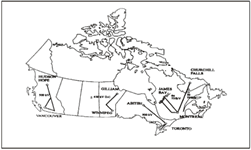National Energy Grid
|
 |
|
Full Size Map National Electricity Transmission Grid of Canada(81kb) |
GRID SUMMARY
Canada was the fifth-largest energy producer in the world in 2000, behind the United States, Russia, China, and Saudi Arabia. Over the past two decades, Canada has become a significant net energy exporter. In 2000, about 30% of Canadian energy production was exported, with the United States by far its main customer.
OIL
From January through August 2002, the United States imported more oil (including crude oil and petroleum products) from Canada than from any other country. The United States also imported about 2.2 trillion cubic feet (Tcf) of Canadian natural gas in the first seven months of 2002, with 93% of total U.S. gas imports coming from Canada. In 2000, about 36% of Canada's primary energy production was natural gas, followed by oil (23%), hydropower (20%), coal (11%), and nuclear power (4%). Over two-thirds of Canada's energy is produced in the province of Alberta. Besides being a major producer, Canada also is a significant energy consumer and a member of the International Energy Agency (IEA). Canada was the world's fifth-largest energy consumer in 2000, roughly on par with India in terms of total energy consumption. Canada has the highest energy intensity of any OECD country.
ELECTRICITY
Canadian electricity generation in 2000 totaled 567.1 billion kilowatt hours (bkwh), of which 60% was hydropower, 26% was conventional thermal power (oil, gas, and coal), 12% was nuclear generation, and 1% was derived from other renewable sources. Canada was the largest producer of hydropower in the world in 2000, and hydro sources are not yet believed to be fully exploited. Trends in coming years are expected to favor thermal power generation, mainly from natural gas. Canadian nuclear output has declined to 69.8 bkwh in 2000, compared to its peak of 102.4 bkwh in 1994. Ontario contains the bulk of Canadian nuclear capacity. Canada exported about 38 bkwh of electricity (gross) to the United States in 2001, mostly from Quebec, Ontario, and New Brunswick to New England and New York. Smaller volumes are exported from British Columbia and Manitoba to Washington state, Minnesota, California, and Oregon. There is considerable reciprocity between the Canadian and U.S. power markets, as the United States also exports smaller volumes of electricity to Canada (18 bkwh in 2001).
ENERGY SUMMARY : CANADA
Map
of Canadian Electricity Grid | National Energy Grid Index
GENI Home Page | Contact
GENI | Subscribe
to GENI Newsletter | Pledge
| Comments
| GENI Forum
Email this page to a friend
If you speak another language fluently and you liked this page, make
a contribution by translating
it! For additional translations check out FreeTranslation.com
(Voor vertaling van Engels tot Nederlands)
(For oversettelse fra Engelsk til Norsk)
(Для дополнительных
переводов проверяют
FreeTranslation.com )

